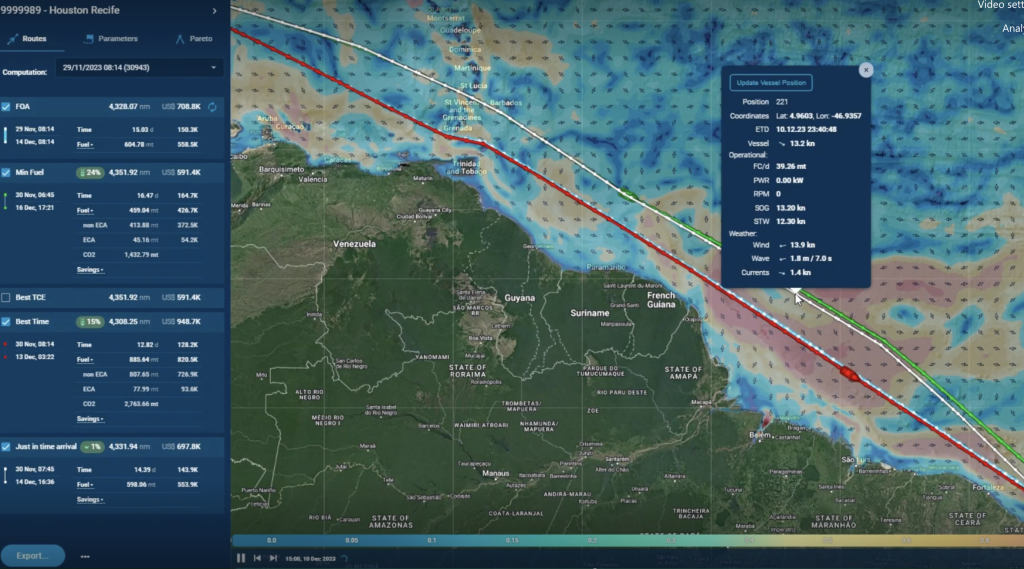Introduction
In the previous blog post, “The Paradigm Shift: Evolution from Weather Routing to Voyage Optimisation”, we detailed how weather routing tools (single-objective optimisation) are incapable of providing multiple optimised voyages with a single computation. Leveraging the power of technological advancements with AI translates into clear business benefits. In this article, we are looking at those benefits and their tangible values.
Advanced Artificial Intelligence
At the heart of voyage optimisation lies the core technology the solution is based on. The first and only multi-objective optimisation solution – T-VOS – is based on a Genetic Algorithm developed in collaboration with our partners, the Alan Turing Institute and the University of Southampton. This state-of-the-art algorithm has been thoroughly tested in both academic and commercial environments. The latest commercial benchmark looked at the algorithm’s efficiency when used with Shell’s JAWS Ship Hydrodynamic Models. This study was published by the Royal Institute of Naval Architects and can be read here
1. Multi-objectivity: Unlocking Latent Efficiencies
A Multi-Objective Algorithm creates a population of potential solutions; it then evolves that population over time using evolution-inspired techniques such as mutation and crossover to find a set of optimal solutions. T-VOS simultaneously considers multiple parameters, evaluating over 300,000 potential voyages in a single computation. The most efficient routes considering multiple objectives such as fuel consumption, voyage duration, departure and arrival times (JITA), Time Charter Equivalent (TCE), Charter Party Compliance, Cii Rating, and safety, etc. Voyage optimisation has undoubtedly become a multi-objective challenge with evolving requirements that will continue changing over the coming years. T-VOS is future-proof as it is simple and fast to incorporate with new information and objectives regardless of the length and complexity of the route. This adaptability is crucial as optimisation needs evolve rapidly over time,
Depending on individual operational priorities, each computation can significantly reduce fuel consumption, emissions and costs.
2. Reducing carbon footprint of each voyage
Environmental issues associated with shipping are on the rise. Multi-objective computations make both sustainability and profitability achievable in equal measure for all operations.
The T-VOS Multi-Objective Optimisation Engine contributes to a greener future without capital expenditure. This aligns with corporate social responsibility, helps meet regulatory requirements, and creates a safer, greener future for all of us.
3. Safety
As safety is a crucial concern with Maritime operations, integrating T-VOS with high-fidelity Met Ocean Data and ship hydrodynamic models, the T-VOS Multi-Objective Genetic Algorithm can very accurately calculate a ship’s performance and behaviour in any weather conditions and advise on seakeeping and weather limit constraints, translating into increased safety
4. Data-rich approach: Enhanced Decision Making
Optimised voyages can be exported using standard data exchange file formats. These data sets contain many data points, including speed, ETA & ETD, Power, RPM, Fuel consumption and Metocean parameters. Leveraging the power of analytics in voyage optimisation is now possible as data sets can be used for performance and post-voyage analysis to streamline operations and provide valuable insights into areas of improvement.
Real-time adjustments may mitigate risks and optimise performance by analysis. This agility ensures businesses can navigate unforeseen challenges and capitalise on emerging opportunities, maintaining their competitive edge in the market.
Conclusion
As demonstrated, voyage optimisation must adhere to changing regulatory frameworks to substantially increase efficiencies. Multi-objective optimisation is the right choice for your business as it can simultaneously consider multiple objectives, make data-driven decisions, and customise solutions to specific needs. Adapting this solution is a strategic step for companies looking for sustainability with improved profitability.

